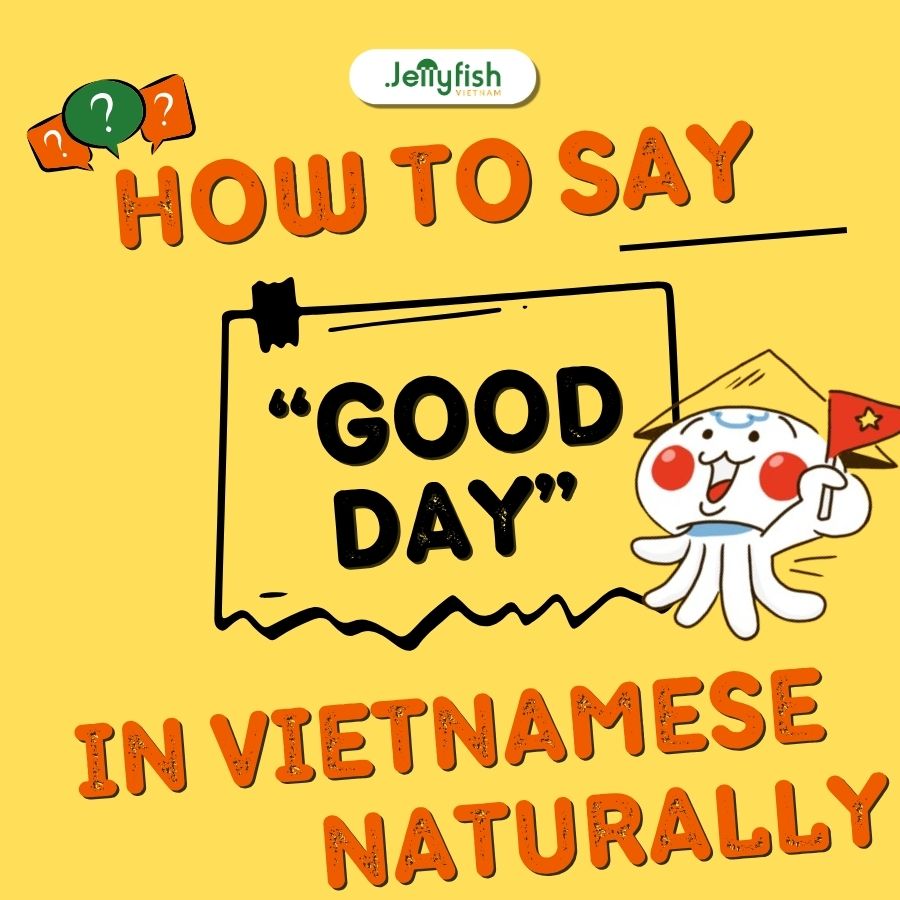If you’re learning Vietnamese or planning a trip to Vietnam, knowing how to say good day in Vietnamese might seem like a simple task. But in reality, Vietnamese greetings are rooted in context, social roles, and timing. In this guide, Jellyfish will walk you through the most natural and respectful ways to say “good day” in Vietnamese, including time-based greetings, casual expressions, and how cultural factors shape the way people greet one another in everyday life.:
1. Is There a Direct Translation for “Good Day”?
- Chào + [name]
This simply means “hello,” but it’s understood as a polite and friendly greeting in most everyday situations. The pronoun is key, as it reflects the age or status of the person you’re greeting.
Example:
- Chào anh – hello, older male
- Chào em – hello, younger person
2. Time-based greetings in Vietnamese
Although there is no single phrase for “good day,” you can still use appropriate greetings based on the time of day. The table below summarizes these common expressions:
| Time of Day | Vietnamese Phrase | Meaning in English | Common Usage Example |
| Morning (before 12 PM) | chào buổi sáng | good morning | chào buổi sáng, thầy |
| Noon (~12–1:30 PM) | chào buổi trưa | good noon / midday | chào buổi trưa, bạn đi ăn chưa? |
| Afternoon (1:30 PM–sunset) | chào buổi chiều | good afternoon | chào buổi chiều, quý khách |
| Evening (after sunset) | chào buổi tối | good evening | chào buổi tối, mọi người |
3. Casual and common Vietnamese greetings
In everyday conversation, especially among peers or in casual settings, Vietnamese people often drop time-specific greetings and simply say:
- Chào – hello
- Chào bạn – hello, friend
- Chào cậu / anh / chị / em – hello + appropriate pronoun
These are easy and friendly alternatives to say “good day” in informal contexts.
Example:
- Chào anh, hôm nay ổn không? – good day, how are you today?
4. Professional and formal greetings
For workplace settings, public speaking, or welcoming guests, Vietnamese has more respectful greeting formats:
- Xin chào quý vị – greetings, distinguished guests
- Xin kính chào – respectfully greeting
- Trân trọng kính chào – formal greeting, very polite
These are appropriate when addressing groups, elders, or during announcements. While they don’t translate literally to “good day,” they serve the same respectful function.
Example:
- Xin kính chào quý vị đại biểu – respectful greetings to the delegates
5. Understanding the Role of Pronouns
Vietnamese greetings revolve around age-based and role-based pronouns. Saying “good day” in Vietnamese without using the correct pronoun could sound awkward or even disrespectful.
| Pronoun | Meaning |
| anh | older male peer |
| chị | older female peer |
| em | younger person |
| cô | older woman / female teacher |
| thầy | male teacher |
| chú | middle-aged man |
| bác | much older person |
| ông/bà | elderly male / female |
Example:
- chào bác – polite hello to a senior person
- chào em – friendly hello to a younger person
6. Useful add-ons to sound more natural
You can combine your greeting with polite follow-up phrases to sound more natural:
- Hôm nay bạn thế nào? – how are you today?
- Chúc bạn một ngày tốt lành – wishing you a good day
- Mọi việc ổn chứ? – is everything okay?
Example: Chào chị, chúc chị một ngày tốt lành – good day, wishing you a great day
7. What not to say
Avoid trying to translate “good day” word-for-word. These phrases are technically correct but unnatural:
- Ngày tốt – sounds robotic and awkward
- Xin chào ngày mới – overly poetic, not used in real conversations
Instead, use:
- Chào + pronoun
- Chào buổi + sáng / trưa / chiều / tối
- Xin chào / kính chào in formal speech
While there is no exact equivalent to “good day” in Vietnamese, you can express this concept naturally through time-appropriate greetings and respectful pronoun use. From casual phrases like “chào anh” to formal expressions like “xin kính chào,” understanding the nuances of Vietnamese greetings will help you communicate confidently and appropriately in any context.
Learn real Vietnamese with Jellyfish
At Jellyfish Education, we provide learners with practical Vietnamese tailored to real-life situations. You will:
- Learn how to greet naturally in formal, casual, and professional settings
- Practice real-life conversation with native instructors
- Build vocabulary and cultural confidence through structured lessons
👉👉 Learning Vietnamese – Jellyfish Vietnam
✦ Hotline: 096 110 6466
✦ Head office: 1st Floor, Web3 Tower Building, Alley 4 Duy Tan Street, Cau Giay District, Hanoi
✦ Branch office: Sholega building, 275 Lach Tray, Ngo Quyen, Hai Phong
✦ Head office in Japan: 4F Westhill Building, Nishigotanda 2-24-4, Shinagawa, Tokyo, Japan


